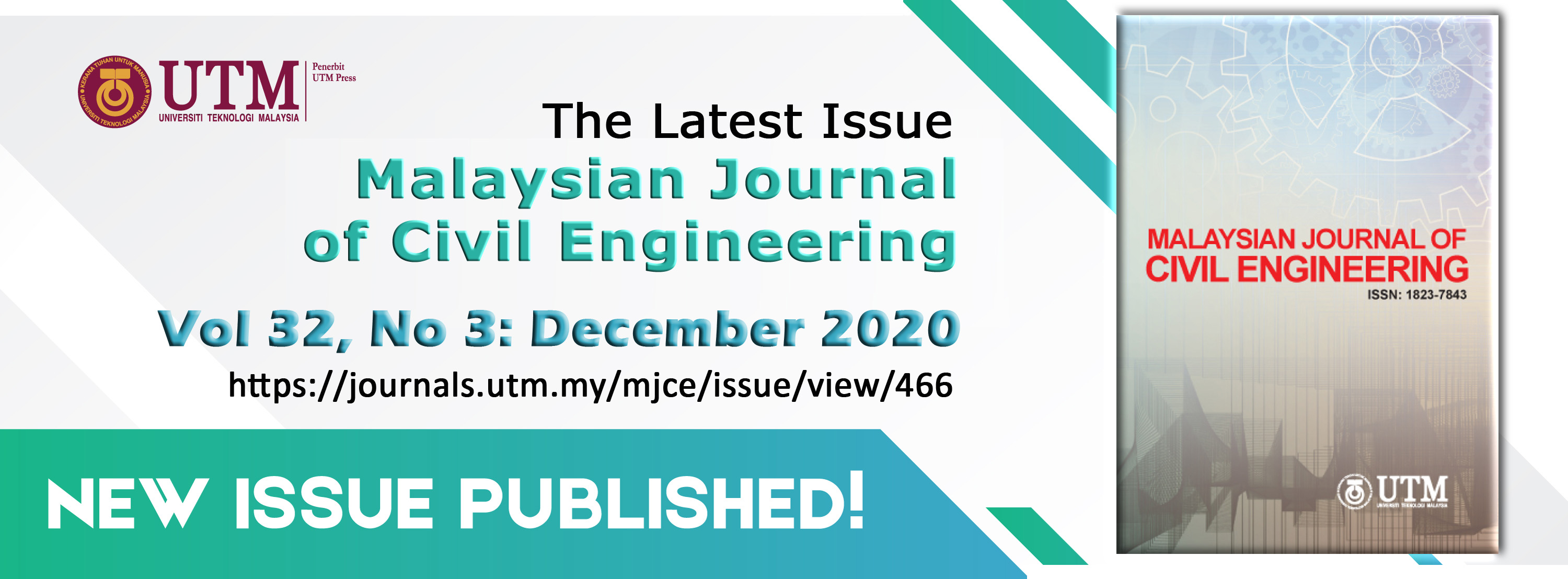INFLUENCE OF WATER-CEMENT RATIO AND WATER REDUCING ADMIXTURES ON THE REBOUND NUMBER OF HARDENED CONCRETE
DOI:
https://doi.org/10.11113/mjce.v32.16219Keywords:
Rebound number, water-reducing admixture, compressive strength, water-cement ratio, correlationAbstract
In this paper, effect of water-cement ratio (w/c) and type of water reducing admixtures (WRA) on the Schmidt hammer rebound number (RN) were investigated. Concrete of mix ratio 1:2:4 was prepared at the w/c of 0.45, 0.50, 0.55 and 0.60 and with each of the three WRA at the w/c of 0.45. Concrete cubes of size 150 mm were cast and cured in water for 3, 7 and 28 days. RNs of the cubes were determined and the compressive strengths (fc) corresponding to the RNs obtained from the conversion graph supplied by the manufacturer were compared with the compressive strengths obtained from crushing machine (CM). The results showed that as the w/c increased, the RN increased up to when w/c was 0.5 and began to drop, while there was no significant effect of all the WRA on the RN. It was also found that fc obtained from CM and those obtained using the conversion graph differed considerably. A new correlation graph was therefore proposed, which showed a correlation coefficient of 0.96, while coefficient of determination obtained for the regression equation between RN and fc, was as high as 0.92. The study concluded that w/c had effect on RN and that the equation developed could be used to determine fc, once RN is known.
References
REFERENCES
Malhotra, V. M., & Carino, N. J. (2004). Handbook on Nondestructive Testing of Concrete. CRC Press.
Zaky, S. (2001). Evaluation of concrete structural members contained different types of coarse aggregate using Schmidt hammer apparatus after 28-day and at later ages. INTER BUILD, 201–214.
Woodson, R. D. (2009). Evaluating concrete in concrete structures. Concrete Structures, 6, 3–18. https://doi.org/doi:10.1016/b978-1-85617-549-4.00002-2
ASTM C805-13. (2013). Standard Test Method for Rebound Number of Hardened Concrete. American Society for Testing and Materials, West Conshohocken, PA.
BS EN 12350-2. (2009). Testing fresh concrete. Slump-test. British Standards Institution.
IS 13311 (Part 2). (2004). Non-Destructive Testing of Concrete - Methods of Test. Bureau of Indian Standards, new Delhi.
Sanchez, K., & Tarranza, N. (2014). Reliability of Rebound Hammer Test in Concrete Compressive Strength Estimation. International Journal of Advances in Agricultural & Environmental Engg. (IJAAEE), 1(2), 198–202.
Rubene, S., & Vilnitis, M. (2014). Use of the Schmidt Rebound Hammer for Non-Destructive Concrete Structure Testing in Field. Technical Transactions: Civil Engineering, 1-B, 13-19.
Shariati, M., Ramli-Sulong, N. H., Arabnejad, M. M., Shafigh, K. H. P., & Sinaei, H. (2011). Assessing the strength of reinforced concrete structures through Ultrasonic Pulse Velocity and Schmidt Rebound Hammer tests. Scientific Research and Essays, 6(1), 213–220.
Brozovsky, J. (2012). Implementation of non-destructive impact hammer testing methods in determination of brick strength. Applied Mechanics and Materials, 174–177, 280–285.
Tamil, S. P., Lakshmi, N. P., & Ramya, G. (2014). Experimental study on concrete using copper slag as replacement material of fie aggregate. Journal of Civil & Environmental Engineering, 4(5), 1–6.
Cargill, J. S., & Shakoor, A. (1990). Evaluation of empirical methods for measuring the uniaxial compressive strength of rock. Int J Rock Mech Min Sci Geomech Abstr, 27, 495–503.
Frauenfelder, R., Laustela, M., & Kääb, A. (2005). Relative age dating of Alpine rock glacier surfaces. Zeitschrift Für Geomorphologie, 49, 145–166.
Amasaki, S. (1991). Estimation of strength of concrete structures by the rebound hammer. CAJ Proc. Cem. Conc, 45, 345–351.
Mitchell, L. J., & Hoagland, G. G. (1961). Investigation of the Impact Tube Concrete Test Hammer. Highway Research Board.
Grieb, W. (1958). Use of the Swiss Hammer for Estimating the Compressive Strength of Hardened Concrete. FHWA Public Roads
Kolek, J. (1958). An Appreciation of the Schmidt Rebound Hammer. Magazine of Concrete Research, 10(28), 27–36.
Yasar, E., & Erdogan, Y. (2004). Estimation of rock physico-mechanical properties using hardness methods. Eng. Geol, 71, 281–288.
Aydin, A., & Basu, A. (2005). The Schmidt hammer in rock material characterization. Eng. Geol, 81, 1–14.
BS EN 1097-3. (1998). Tests for Mechanical and Physical Properties Of Aggregates. British Standards Institution
Peck, R. B., Hanson, W. E., & Thornburn, T. H. (1974). Foundation engineering (2nd ed.). John Wiley, New York.
BS EN 12350 (2009). Testing of fresh concrete. British Standards Institution.
BS EN 12390-3. (2009). Testing hardened concrete: Compressive strength of test specimens. British Standards Institution.
Kennedy, J. B., & Neville, A. M. (1986). Basic Statistical Methods for Engineers and Scientists. Donnelley Publishers.
Shetty, M. S. (2005). Concrete Technology: Theory and Practice (Multicolour Revised Ed). S. Chand & Company Ltd. New Delhi.
Neville, A. M (2005). Properties of Concrete, Pearson Education Limited, UK. 5th Edition.
Newman, J., & Choo, B. S. (2003). Advanced Concrete Technology - Concrete Properties. Butterworth-Heinemann, Elsevier Ltd., England.
















